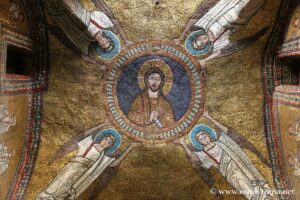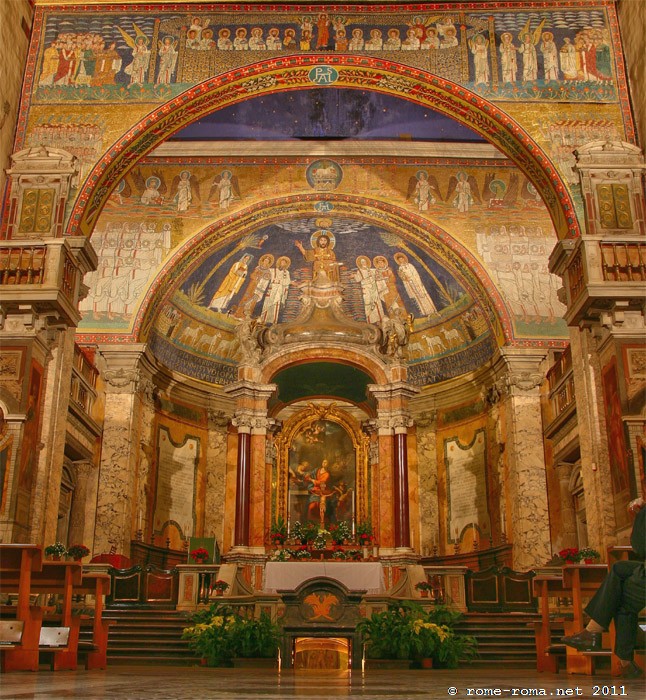The basilica church of Saint Praxedes (Santa Prassede in Italian) was built starting in 822 by Pope Pascual I.
It is located in the Rione Monti, the district of the Basilica of Saint Mary Major, and is dedicated to Praxedes, sister of Pudentiana (whose homonymous church Santa Pudenziana is located in the same district) and daughter of a Roman senator said to have been the first Christian converted by Saint Paul. On its site there was probably an oratory as early as the year 150 AD and a church around the end of the 5th century.
Visit and description of the church
The external architecture of the church is barely visible, due to many reconstructions and especially because of its integration into the urban fabric over time, with adjacent houses and shops. The entrance is therefore through a side door, and the façade can be seen when passing through the church, facing onto a small courtyard.
This basilica is rich in many early Christian mosaics created under Pope Paschal I, such as those of the choir as well as those in the Chapel of Saint Zeno, which was dedicated to the pope’s mother, Theodora.
Divided into three naves, with transept and apse, the columns and pillars support reinforcing arches from the 13th century. Like most early Christian basilicas, it preserves a ciborium.
Splendid frescoes decorate the walls with stories of the Passion. The pillars are decorated with figures of the apostles, cherubs, and festoons, dating from the early 17th century.
The cosmatesque-style paving of the nave is remarkable. On either side of the sanctuary, six beautiful Roman columns stand out for their unusual style.
At the center of the floor, a porphyry disk covers a well where, according to legend, Saint Praxedes collected the remains and blood of martyrs.
The apse mosaics date back to the 9th century. In the upper part of the choir, Christ is surrounded by Saint Peter, Saint Pudentiana, Saint Zeno, Saint Praxedes, and Pope Paschal I, with a halo, holding a model of the church (see apse mosaics).
The Chapel of Saint Zeno (San Zenone) is the most important Byzantine work of this type preserved in Rome, and it is the only chapel in the city entirely covered with mosaics.
It is also notable for preserving a representation of the Garden of Paradise (see Chapel of Saint Zeno).
A chapel holds a fragment of the Column of the Flagellation of Christ (according to the account of Saint Helena, mother of Emperor Constantine). This relic was brought to Rome by Cardinal Giovanni Colonna in 1223.
In the right nave, the tomb of Bishop Giovanni Battista Santoni is adorned with a bust, which was the first work of Bernini.
Among the various chapels, the Olgiati Chapel was built by Martino Longhi the Elder (16th century), and its vault is covered with frescoes painted by the Cavalier d’Arpino.
The crypt houses the tomb of Saint Praxedes and an ancient fresco representing her.
Apse and triumphal arch
The apse mosaics date back to the 9th century. In the upper part of the choir, Christ the Redeemer is surrounded by Saint Peter, Saint Pudentiana, Saint Zeno, Saint Praxedes, and Pope Paschal I, with a halo, holding a model of the church.
In the lower part, at the center, Christ and the Paschal Lamb stand on a small hill from which flow the four rivers of paradise. The other 12 lambs represent the apostles, next to which are depicted the cities of Bethlehem (to the left) and Jerusalem (to the right). The inscription by Pope Paschal I mentions his hope that the new construction offered to Christ would guarantee him a place in paradise.
The mosaics of the arch of the apse refer to the Book of Revelation (chapters 4 and 5), with at the foot of Christ the seven candlesticks identifying the churches of Asia, and the four evangelists.
The triumphal arch refers to chapter 21 of the Book of Revelation. The figures are represented in a citadel (the Heavenly Jerusalem) with Christ flanked by two angels, and below Mary, John the Baptist, Saint Praxedes, and the twelve apostles. On the sides are depicted Moses holding the Tablets of the Law and the prophet Elijah. Outside the citadel, on two levels, are shown Peter and Paul, the bishops, the martyrs, and others.
Chapel of Saint Zeno
On the exterior decoration of the Chapel of Saint Zeno, an arch around the window shows the image of the Virgin and Child at the center, with figures of saints. On the outer arch appear Christ and the twelve apostles.
Originally, there was only one entrance; two doors were later added, giving access to the Coëtivy Chapel and to that of the Column of the Flagellation.
In the corners of the room, the columns with gilded capitals serve as a “pedestal” for the four angels on the vault holding a medallion with Christ Pantocrator.
The mosaics of the left wall are divided into three parts: at the top, Saints Agnes, Pudentiana, and Praxedes hold the crown of martyrdom. Below is the scene of Adam and Eve being freed from hell by Jesus. Then, in the lower niche, the Lamb-Christ stands on a mountain with two stags drinking from the four rivers, and below, the Virgin, Saints Praxedes, Pudentiana, and Theodora (mother of Paschal I).
On the wall facing the entrance, at the top, appear full figures of Mary and Saint John the Baptist. In the next niche is represented the Transfiguration, with Christ, Moses, Elijah, and the apostles Peter, John, and James. Below stands the altar, and in the aedicule a mosaic shows the Virgin holding the Child, who holds a scroll with the inscription: “Ego sum lux” (I am the light), surrounded by Saints Praxedes and Pudentiana.
On the right wall are the figures of the Evangelist John (holding the Gospel) and the apostles Andrew and James. In the lunette are seen the busts of Christ and two saints.
Map and address
Address : Via di Santa Prassede, 9/a, 00184 Roma RM, ItalieIf you see this after your page is loaded completely, leafletJS files are missing.
Photos and visit of the church
Apse and triumphal arch
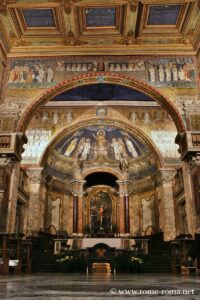

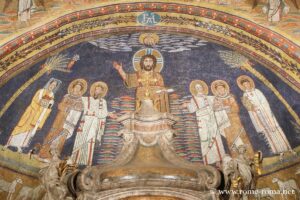
Nave of the basilica
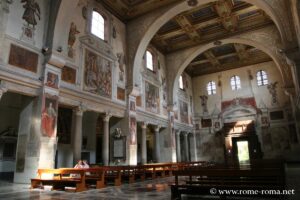
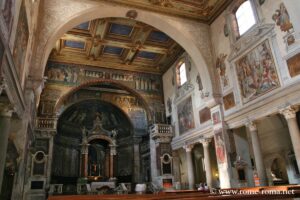
Saint-Zeno Chapel
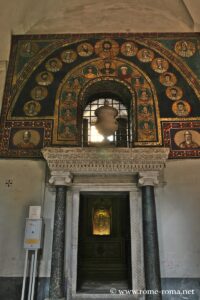

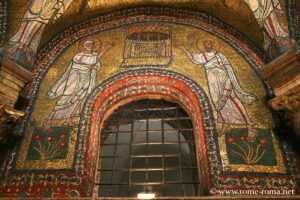
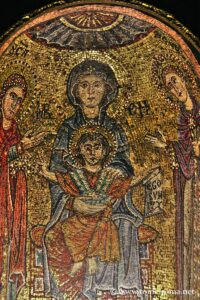
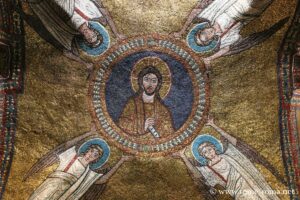
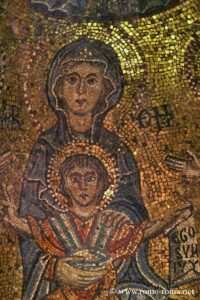
Crypt of the church
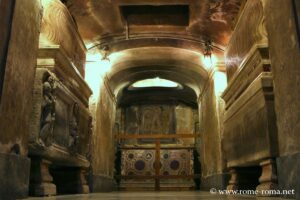
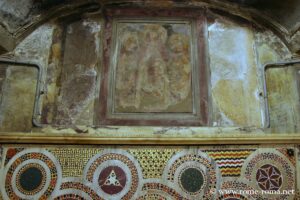
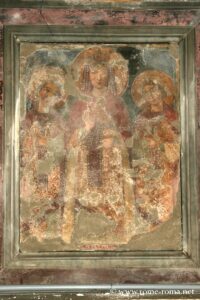
Information
Basilica of Saint Praxedes at the Esquiline |
| Opening hours (to be confirmed) Monday – Saturday: 10am – 12pm / 4pm – 6pm |
Sources and further information: |

